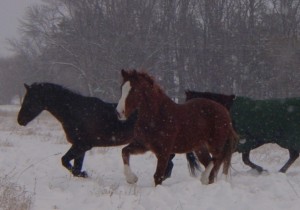Horse Body Condition. Beware of Loss of Body Condition in Cold Weather

Cold weather, especially temperatures below freezing and cold rains, necessitates owners paying close attention to their horses. It is important to ensure that the horses maintain weight throughout the winter months.
Monitoring and Maintaining Body Condition Score
First, make certain the horses are at least a body condition score of 5 or 6. This means that the horses are carrying some fat cover over their ribs. Body condition should be monitored by physical examination at least monthly as long hair can hide weight loss. This is particularly important for older horses. The horses should also be kept up to date on dental care and overall health care, including appropriate deworming. It is a good idea to let horses go barefoot with proper hoof care during the winter.
Water Availability and Temperature Considerations
Adequate water, above 40 degrees Fahrenheit, should be available at all times. If water sources freeze, the ice should be broken at least twice per day. Owners should NOT rely on horses eating snow for their water supply. A 1200-pound horse will require 12-15 gallons of water per day during cold weather. Having inadequate water available or water that is too cold for horses to drink comfortably may contribute to impaction colic. A horse that does not have adequate water available will also decrease feed intake. This may lead to loss of body condition. Salt should be available free choice, preferably loose salt rather than a salt block as horses may not lick a cold salt block.
Shelter from Cold Rains and Wind
Provide shelter from cold rains and wind. Horses remain remarkably comfortable in cold weather if they are dry and have shelter from the wind. Cold rains mat down the hair coat, reducing the insulation value of the hair and causing the horses to lose body heat. State regulations may dictate shelter requirements.
Adjusting Feed to Meet Increased Energy Requirements
Fourth, feed more! A horse’s digestible energy requirement increases for each degree below the thermal neutral zone. Wind chill increases the energy requirement also. Hay or high fiber products produce more heat during digestion than do grains, so adding extra good quality roughage to the diet is a good option. Grain intake can also be adjusted to maintain the desired body condition, but needs to be adjusted gradually.
Calculating Energy Requirements for Cold Weather
A 1200 lb. horse at maintenance requires about 17.7 Mcal (17,700 Calories) of DE for maintenance. Each degree C below Lower Critical Temperature (Anywhere from 5 degrees C or 40 degrees F down, depending on what the horse is used to.) increases DE requirement about 2.5%. (NRC, 6th Edition, page 10-11.) Converting to Fahrenheit, each degree drop requires about 1.375%, so if the temperature drops from 10 degrees F to 0 degrees F, the DE requirement may increase 13.75% to 20.13 Mcal or 20,130 Calories. This increase of 2430 Calories would require an additional 2.8 pounds of alfalfa grass hay to maintain body condition. If the horse does NOT get the additional DE, the horse could lose a little over a quarter of a lb. per day. If we have 3 months of cold weather, it is very easy for a horse to drop a full body condition score. Shorter periods of extreme cold may cause more rapid loss of weight.
Proper winter care will help assure that your horse is ready for spring!
Ready to ensure your horse is getting the optimum nutrition at feeding time, every time? Find the perfect feed formulated specifically for horse’s needs with our Feed Selector Tool.
